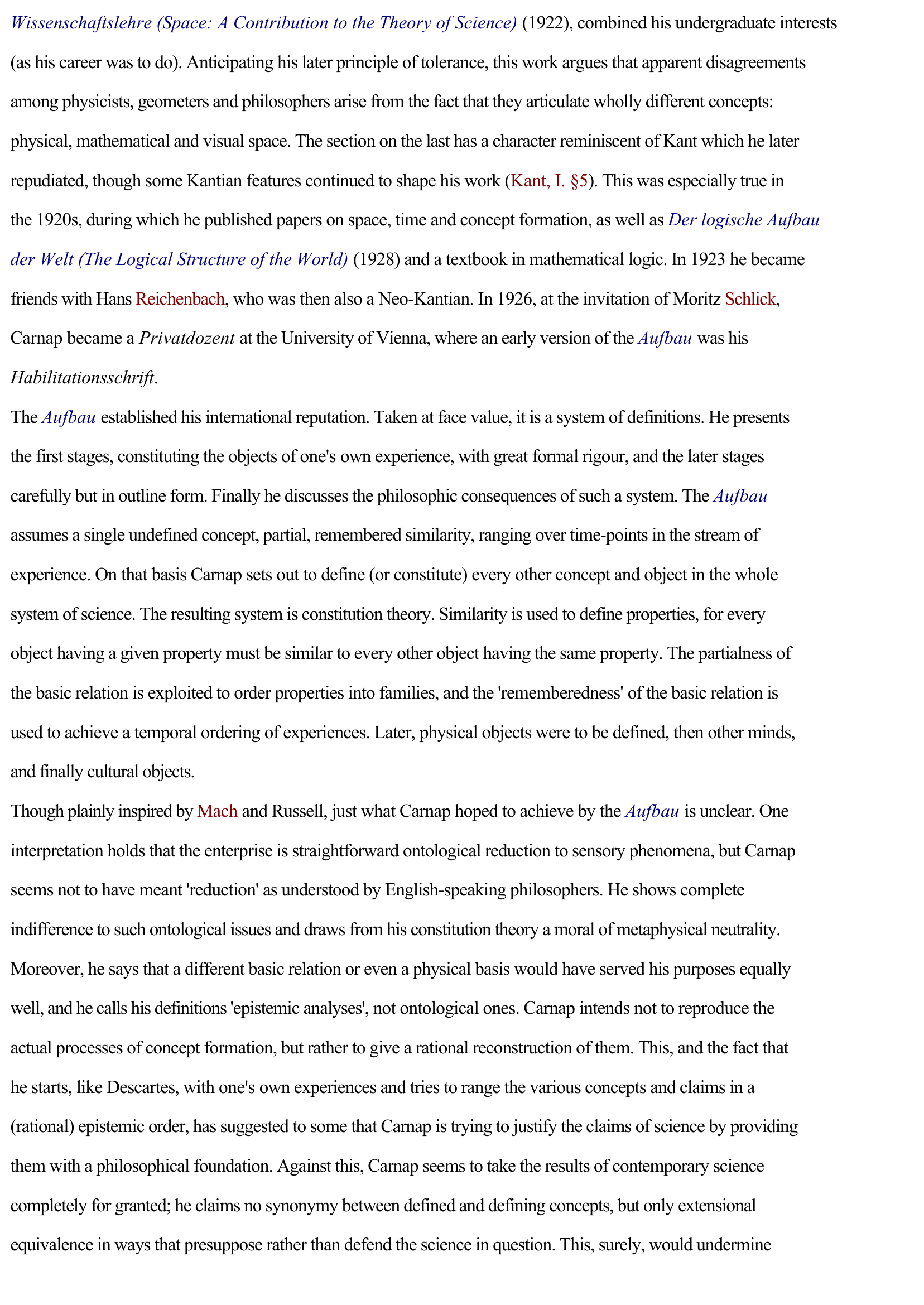Carnap, Rudolf
Publié le 22/02/2012
Extrait du document
«
Wissenschaftslehre (Space: A Contribution to the Theory of Science) (1922), combined his undergraduate interests
(as his career was to do).
Anticipating his later principle of tolerance, this work argues that apparent disagreements
among physicists, geometers and philosophers arise from the fact that they articulate wholly different concepts:
physical, mathematical and visual space.
The section on the last has a character reminiscent of Kant which he later
repudiated, though some Kantian features continued to shape his work ( Kant, I.
§5 ).
This was especially true in
the 1920s, during which he published papers on space, time and concept formation, as well as Der logische Aufbau
der Welt (The Logical Structure of the World) (1928) and a textbook in mathematical logic.
In 1923 he became
friends with Hans Reichenbach , who was then also a Neo-Kantian.
In 1926, at the invitation of Moritz Schlick ,
Carnap became a Privatdozent at the University of Vienna, where an early version of the Aufbau was his
Habilitationsschrift .
The Aufbau established his international reputation.
Taken at face value, it is a system of definitions.
He presents
the first stages, constituting the objects of one's own experience, with great formal rigour, and the later stages
carefully but in outline form.
Finally he discusses the philosophic consequences of such a system.
The Aufbau
assumes a single undefined concept, partial, remembered similarity, ranging over time-points in the stream of
experience.
On that basis Carnap sets out to define (or constitute) every other concept and object in the whole
system of science.
The resulting system is constitution theory.
Similarity is used to define properties, for every
object having a given property must be similar to every other object having the same property.
The partialness of
the basic relation is exploited to order properties into families, and the 'rememberedness' of the basic relation is
used to achieve a temporal ordering of experiences.
Later, physical objects were to be defined, then other minds,
and finally cultural objects.
Though plainly inspired by Mach and Russell, just what Carnap hoped to achieve by the Aufbau is unclear.
One
interpretation holds that the enterprise is straightforward ontological reduction to sensory phenomena, but Carnap
seems not to have meant 'reduction' as understood by English-speaking philosophers.
He shows complete
indifference to such ontological issues and draws from his constitution theory a moral of metaphysical neutrality.
Moreover, he says that a different basic relation or even a physical basis would have served his purposes equally
well, and he calls his definitions 'epistemic analyses' , not ontological ones.
Carnap intends not to reproduce the
actual processes of concept formation, but rather to give a rational reconstruction of them.
This, and the fact that
he starts, like Descartes, with one's own experiences and tries to range the various concepts and claims in a
(rational) epistemic order, has suggested to some that Carnap is trying to justify the claims of science by providing
them with a philosophical foundation.
Against this, Carnap seems to take the results of contemporary science
completely for granted; he claims no synonymy between defined and defining concepts, but only extensional
equivalence in ways that presuppose rather than defend the science in question.
This, surely, would undermine.
»
↓↓↓ APERÇU DU DOCUMENT ↓↓↓
Liens utiles
- SIGNIFICATION ET NÉCESSITÉ, Rudolf Carnap (résumé & analyse)
- STRUCTURE LOGIQUE DU MONDE (LA), Rudolf Carnap
- Carnap, Rudolf - philosophie.
- Qui était CARNAP (Rudolf) ?
- Qui était Rudolf CARNAP ?

































